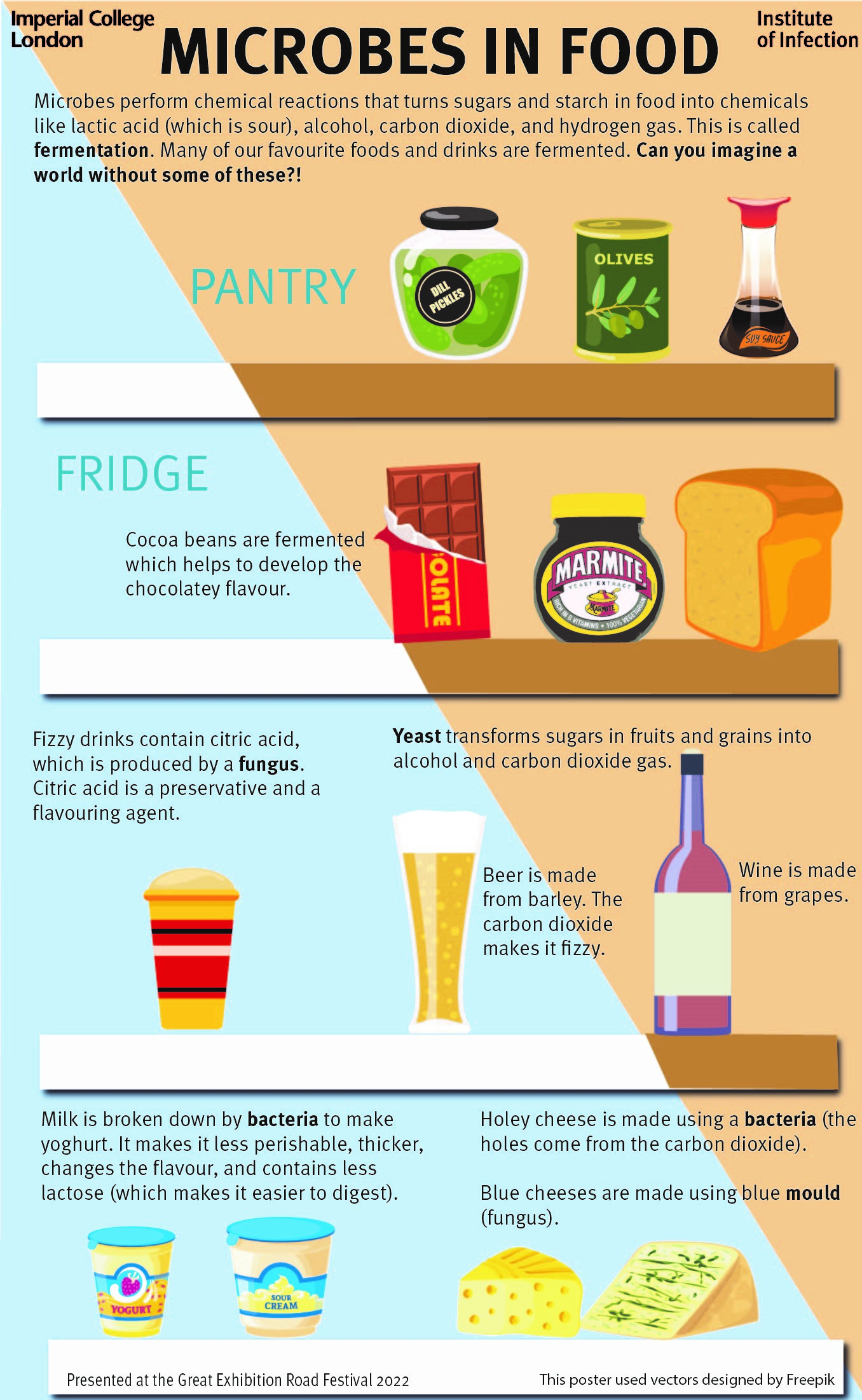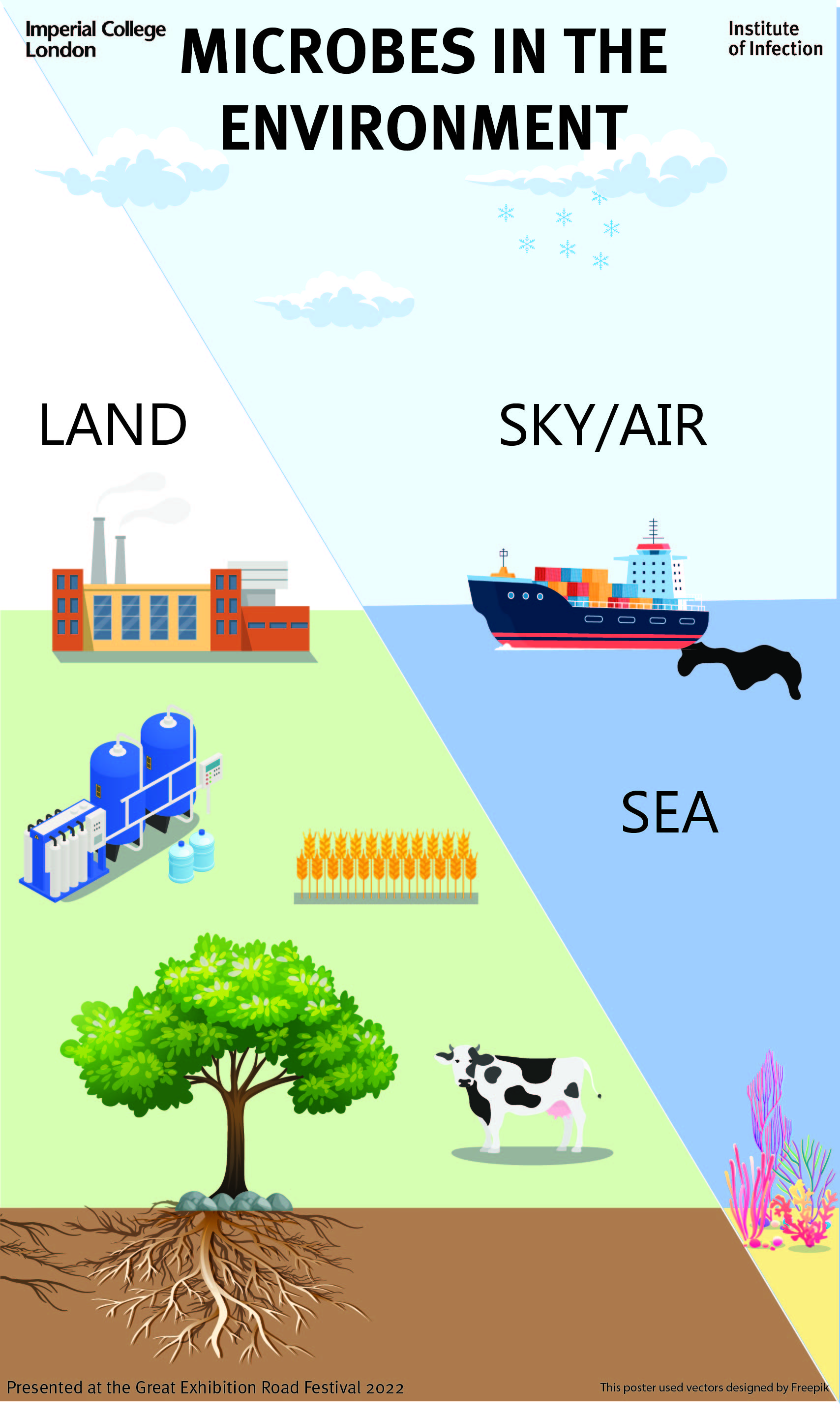Our world would look very different without microbes. Explore just some of the ways microbes help keep us healthy, control the environment, and make some of our favourite foods.
 Microbes in Health poster text (readable format)
Microbes in Health poster text (readable format)
 Microbes in Food poster text (readable format)
Microbes in Food poster text (readable format)
Microbes in the Environment
Up in the clouds
- For clouds to form, there needs to be something (like a speck of dust) for the water to collect onto. Sometimes, a floating microbe can do this.
- Some microbes have special proteins on their surface, which causes ice to form at warmer temperatures than normal and can help seed hail and snow.
- One plant pathogen, pseudomonas syringae, has a specialised ice crystallization protein, which is used in machines that make artificial snow.
AMAZING! Bacteria can catch rides on raindrops and wind. They have been found 9 miles above us & can have travelled from the other side of the world!
Phenomenal Phytoplankton
Phytoplankton are microalgae which:
- Serve as the base of the ocean’s food chain
- Via photosynthesis, produce more than half of the oxygen we breathe and absorb carbon dioxide from the atmosphere.
Bacterial clean up of oil spills? Not a reality yet: Certain bacteria in our oceans break down the naturally-occurring oils which seep from the seabed. Some researchers think that one day they could be used to clean up oil spills. It’s not possible yet, but some scientists are hopeful that one day we will be able to find ways to harness this power.
Ocean clean up
- Marine food web: The oceans are filled with waste from dead organisms. This “dissolved organic material” is nutritious but is too small for larger animals to use.
- Helpfully, bacteria absorb these nutrients, which recycles them back into the food chain when the bacteria are consumed by the larger animals.
- Viruses play a big role in this system because they kill vast amounts of bacteria and other organisms in the ocean. Most of the dissolved organic matter in the oceans is a product of this.
Did you know? Viruses are found in every environment on Earth, but their importance is perhaps most evident in the oceans.
Co-existing with Corals
- Corals and certain bacteria rely on one another to live (symbiosis).
- Corals supply the microbes with food and protection.
- Microbes supplying corals with nitrogen, break down toxic waste, & provide nutrients to the coral’s symbiotic algae partner.
Fantastic facts:
- A teaspoon of seawater typically contains about fifty million viruses.
- If you weighed all the living organisms in the ocean, 90% of that weight would be from microbes.
- The “smell of the sea” come from a substance called dimethyl sulfide, which is produced when bacteria breakdown chemicals produced by phytoplankton.
Cycling of life
- Bacteria and fungi are essential decomposers. As key players in the circle of life, they break down material from dead plants and animals and turn it into nutrients for plants to use. Without them, all our waste would just pile up and the nutrient flow through our ecosystem would be halted.
- Nitrogen is an important element to all life on Earth. Bacteria are essential for the nitrogen cycle because they change nitrogen in the atmosphere into a form that is usable by plants and animals.
The Wonderful Wood Wide Web
Did you know that trees "talk to each other?!
- They do this via complex and huge networks of mycorrhizal fungi.
- This Wood Wide Web connects about 90% of land plants.
- It allows plants to distribute resources and communicate with each other about dangers like insect infestations.
- This fungi-plant relationship has existed for four hundred and fifty million years old.
Strange but true: The largest organism on earth is an underground fungus. It covers 4 square miles of a forest in America and is thousands of years old.
Looking to the future
- Certain bacteria and fungi can break down plastics. Could these be the future of waste disposal?
- Fungi and algae are may play an increasingly important role in producing biofuels.
- Fungus may be the plastic of the future! This technology is based around their ability to form robust network structures.
- Fungi have been proven to be a cheap and effective way for removing contaminants from damaged environments or wastewater.
- Scientists are exploiting various ways that bacteria, viruses, fungi, and parasites can be used as pesticides in agriculture.
